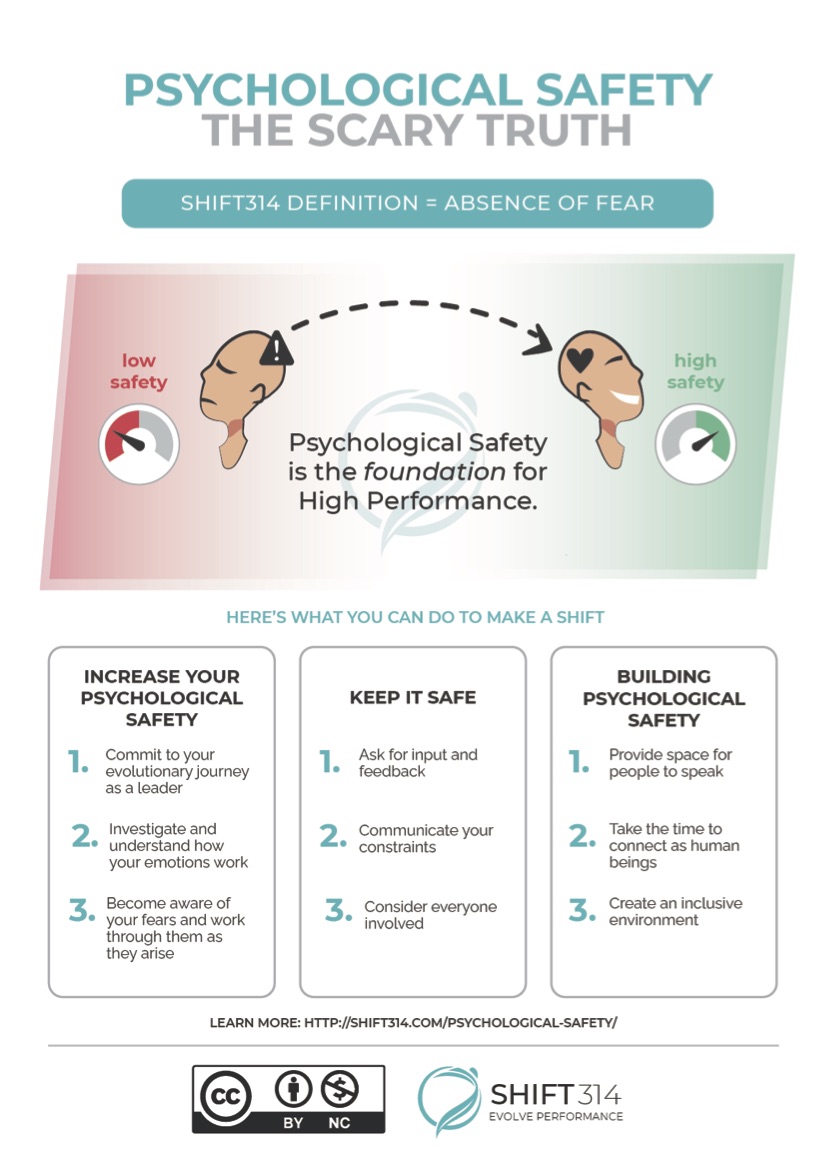Psychological safety is the single most important part of creating a high-performance team or organization. When you have high psychological safety, you have the foundation for high performance. If you do not have psychological safety in your team and your organization, it’s virtually impossible to get high-performance levels.
Psychological Safety – The Foundation of Performance
Everybody in your team or organization is a human being, and human beings have this interesting thing called a frontal cortex: the seat of our reasoning. When we have higher levels of psychological safety, the blood supply to our frontal cortex is really good. But when we have lower levels of psychological safety, the blood supply actually gets cut off. We go into fight or flight or flight mode and the blood supply to our frontal cortex shuts off. We can’t think anymore.
If you want to accomplish anything in your organization, get your projects delivered, or evolve your organizational system, that’s only possible when there’s a high level of psychological safety. That’s why it’s the single most important ingredient for high performance.

What Is Psychological Safety?
The SHIFT314 definition for psychological safety is: the absence of fear.
I am not in fear of:
- What other people think about me.
- If other people think I am doing my job well.
- Proposing an idea.
- Giving honest feedback.
That’s what psychological safety is: It means that we’re not fearful, we’re not afraid. We can do what we need to do to be successful, to take action, to move the work of our team or organization, or our family system, forward.
Download Summary on Psychological Safety
Here is a 1 page downloadable summary of the article – you are welcome to print or save for reference. It’s free under creative commons licence for non-commercial use with attribution.

Moving Beyond Traditional Understanding
The definition we’re giving you is fundamentally different from the current leading definition by Amy Edmondson, a published researcher who’s written a book on psychological safety. In contrast with Edmonson, psychological safety applies in every environment we’re in, whether it’s with our friends, with our family, or at work.
Additionally, psychological safety is a really inner trait. Of course, the environment around us could help lift or lower our psychological safety levels. But, ultimately, it’s an inner trait. It’s the inner story we tell ourselves of, “Am I safe?“

Organizational Impact of Low Psychological Safety
If you’re doing anything like business-as-usual – a traditional hierarchical organization – you’re guaranteed to have terrible levels of psychological safety.
No one will ever talk about the term directly, but what will happen is you’ll hear about people feeling like they’re under stress or under pressure. People may be experiencing work-related illnesses or long-term disability because they can’t cope with what’s happening in the workplace. It’s very normal for these chronic problems to exist.

Low safety levels also show up as low levels of employee engagement. If employee engagement scores aren’t really high, it means that there’s a challenge around psychological safety.
Another way you’ll notice low safety levels is when people won’t speak up. People won’t volunteer ideas. People won’t voluntarily help and reach out to other people or other parts of the organization to help them. That’s how you know there’s a psychological safety challenge.
Safety Starts with You
You can only give what you have. As a leader, when you have a high level of psychological safety, only then can you give it to others. Because, ultimately, psychological safety is an energetic transmission. It’s not a tactic or a technique.
It’s about asking whether you, as a human being, feel psychologically safe. Do you feel secure? Are you able to navigate your fears? It’s not about being perfect or saying fear doesn’t come up. But when fear comes up, are you able to look at your fear in the eye and move forward past it?
Here are some things you can do to increase your own psychological safety.

#1. Commit to your evolutionary journey as a leader
When leaders see the importance of increasing their own psychological safety, they often jump to asking for a technique or a tactic that they can use. But it’s not some sort of knowledge that will help you. It’s actually a commitment to your evolutionary journey as a leader to shift your consciousness and your mindset. That’s what it takes to increase your level of psychological safety.
#2. Investigate and understand how your emotions work
Increasing psychological safety is an investment in understanding how your emotional system works because fear, the opposite of psychological safety, is an emotion. So, commit to investigating and understanding your emotions.
#3. Become aware of your fears and work through them as they arise
The third step is to become aware of your fear and work through your fear when it arises. As normal human beings, we experience fear hundreds of times a day, but we don’t pay attention to it. We actually just ignore it. So, the third point is to become aware and pay attention and to begin creating a shift in your emotional system so that you’re no longer in fear. That’s the work of increasing your level of psychological safety. It’s not about building safety. It’s about decreasing fear.

Psychological Safety – Focus on Prevention
Ninety percent of what we can do to help psychological safety is to stop causing damage. To understand that, as leaders, we are routinely damaging the psychological safety of people around us, and we’re not even aware of it. The doing side of the equation is to become aware of those places that we’re causing damage and to stop.
#1. Ask for input and feedback
The number one killer of psychological safety is making decisions without asking for input or feedback – because that means people are not safe to express their ideas. If you wanted their ideas, you’d ask them for them. So, stop making decisions without asking for people’s ideas.
#2. Communicate your constraints
Let’s face it. As leaders, many things are passed down to us from higher up the hierarchy or by the organizational environment that we’re in. We have a certain client, we’ve got a contract, we have certain legal terms, et cetera.
Explain to people what decisions and constraints are out of your control and what decisions you can work with them on. When people understand what the constraints are and that you are collectively working together, it doesn’t feel like you’re making them do things. It feels like you’re on the same team, which will support their psychological safety.

#3. Consider everyone involved
The third killer of psychological safety is not thinking about the people involved. Oftentimes, as leaders, we’re busy, and we’re making decisions on tight timelines. High-performance leaders take the time to think about the people involved and the impact on them. So, what does this look like practically?
It’s the simple act of thinking, “Well, how’s this going to turn out? What’s the impact on the people involved? Have I consulted appropriately? How are people going to react to this?” We can solve problems, all the damage we’re causing, in simulation-time so we can reach a better decision in real life.
How to Build Psychological Safety in Your Organization
#1. Provide space and time for people to speak
The first thing leaders can do to build psychological safety is to give space and time for everyone to say something. You might say, “What? All I need to do, as a leader, is give space and time for other people to say something?” Well, yes.
When you take time for other people to speak, it elevates their status. It tells them, “Hey, you’re important.” When you tell people, “Hey, you’re important. Your status matters,” and you lower your status relatively, it makes them feel more psychologically safe.

You can start meetings with something simple like, “Hey, everyone. Say your name, and the one word for how you are right now.” And then you go first: “I’m Michael, and I’m feeling excited” (or whatever your check-in is). That simple act of having people say their name and a word for how they are is a great way to build psychological safety.
#2. Take the time to connect as human beings
There are some managers who think talking about what’s happening in the world, the news, or in sports, is a complete and utter waste of time. They’re correct that discussion is a waste of time for getting the work done immediately, but these discussions are invaluable for building psychological safety and team cohesion–– the foundation of results and performance.
You can think of all that human connection time as a great investment in the team’s health – something that’s actually needed for the team to function. It’s kind of like the oil to make sure that the gears work smoothly. Without that oil, there’s going to be a lot of grinding and a lot of extra energy to get things done. So, when people can connect as human beings, it really creates a great opportunity for supporting that.

#3. Create an inclusive environment
The third thing that leaders can do is create an inclusive environment. Just be yourself. Show your real background when you’re on a video conference. Have your kids come on-screen. Introduce people to your pets.
That authentic connection is what fuels people’s psychological safety because, as it turns out, everyone in your organization is a human being first and an employee second. When you connect as a human being, it elevates their function as an employee because they’re going to feel safer. Because if you’re a normal person, and you’ve got a pet or kids coming on, it’s okay if that stuff happens on their end too.
Conclusion
The scary truth about Psychological Safety is that it requires an inner shift.
The creation of psychological safety is an evolutionary journey for people and the organizational system as a whole. As leaders, we can do a lot to create safer environments to unlock people’s ability to function and contribute. Ultimately, for ourselves as leaders and the people we look after this requires an inner shift in our being – a shift in consciousness – as well as learning new skills. This is what we call Evolutionary Leadership: the choice to evolve ourselves. We invite you to join us on this journey to become our better selves and through that create better workplaces and ultimately a better world. Change starts with us.



